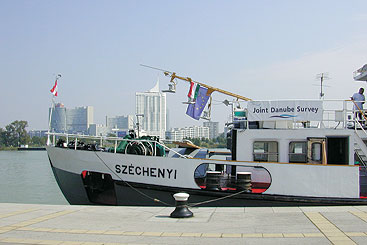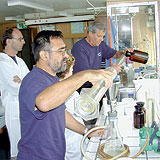Million-euro boat expedition to test Danube pollution
ICPDR Danube Watch: Searching for heavy metals behind the Iron Gates

Million-euro boat expedition to test Danube pollution
The Second Joint Danube Survey launches this summer to collect and analyse samples taken from the river to improve the validity and comparability of water quality data received from its regular monitoring programme, the Trans-National Monitoring Network.

Three boats have been donated from different countries and institutions for use by the JDS2 Team: Serbia’s Argus will serve as the main research vessel; Hungary’s Széchényi ice-breaker will carry cargo and supplies; and the EU’s Joint Research Centre ship Piscus will assess fish species.
The Joint Danube Survey 2, also known as ‘JDS2’, is the world’s biggest river research expedition in 2007. Its main goal is to produce highly comparable and reliable information on water quality and pollution for the entire Danube River and many of its tributaries. The ICPDR coordinates the implementation of JDS2.
Launched on August 14, 2007, from Regensburg, Germany, the three boats of the JDS2 will travel 2,375 km along the Danube River, through 10 countries, down to the Danube Delta in Romania until late September.
Water pollution is a major problem in the Danube River Basin. Danube governments need to make sound decisions about what future measures they will take to reduce Danube pollution and improve ecological health. This will help them to meet their obligations to implement the ‘Danube River Protection Convention’ which they signed in 1998, as well as the EU Water Framework Directive (WFD) – possibly the world’s strongest water legislation. Nutrient, organic and hazardous pollution are all factors that could result in governments failing to meet this EU law.
As a basis for their sound decision-making, Danube countries need high quality and comparable data and information. The JDS2 follows up, and will compare results over time with the work done during the first Joint Danube Survey (JDS1) in 2001. JDS2 also expands on the JDS1 by adding new parameters and sampling locations, and key Danube tributaries will be tested for the first time. The collected information will further enable the ICPDR to have some of the most progressive river databases anywhere in the world – for example, in presenting information on thousands of species dependent on the river.


The full-time International Team travelling the entire length of the Danube will include 18 scientists from Germany, Austria, the Czech Republic, Slovakia, Hungary, Serbia, Romania and Denmark. Teams of national scientists will also help with sampling and testing on board the ships on river stretches within their countries.
JDS2 partners and cooperation. The expedition
has attracted significant international cooperation
from all 10 of the main Danube countries from Germany
to Ukraine, including EU and non-EU members.
The full-time International Team travelling the entire
length of the Danube will include 18 scientists from
Germany, Austria, the Czech Republic, Slovakia,
Hungary, Serbia, Romania and Denmark. The Team
will use three boats donated from different countries
and institutions: Serbia’s Argus will serve as the main
research vessel; Hungary’s Széchényi ice-breaker will
carry cargo and supplies; and the EU’s Joint Research
Centre ship Piscius will assess fish species. Teams of
national scientists will also help with sampling and
testing on board the ships on river stretches within
their countries.
“The level of excitement and commitment is incredible”, says Philip Weller, Executive Secretary of the ICPDR. “We even have support from scientific laboratories across Europe and the private sector. In more ways than one, the people involved prove that the Danube is truly the world’s most international river basin.
It’s also important to keep in mind that both the planning and implementation of the entire JDS2 are highly complex tasks, requiring inputs and agreement from many stakeholders, logistic precision, administrative support and financing”, adds Weller. “Working and living conditions on the boats can and do become difficult over such a long period of time and in such a variety of locations, testing human perseverance. Cooperation and teamwork are therefore essential ingredients for the success of the expedition.”
Some of the actual scientific testing will take place en
route, from analysing water samples at the Argus’s
own laboratory to electro-fishing along the Danube’s
banks. Other samples will be sent to laboratories
throughout Europe for testing – all centres of excellence
for particular water quality parameters. Significant
support was provided by private sector companies
operating in the Danube Basin including the Alcoa Foundation, Dexia Kommunalkredit Bank and
Coca-Cola Hellenic Bottling Company. Finally, local
authorities and the media living near the Danube will
help in raising awareness and concern about Danube
pollution and the need for everyone to participate in
making the Danube clean and healthy.

Much of the scientific testing, such as analysing water samples, will be done in the Argus’s own laboratory while en
route. Other samples will be sent to laboratories throughout Europe for testing.
Danube water monitoring through the ages. The Danube has an extensive history of water quality monitoring. It began with the 1985 ‘Bucharest Declaration’ which led to a series of monitoring stations for the basin. In 1992, the development of the Trans- National Monitoring Network (TNMN) for the Danube River was launched. Coordinated by the ICPDR, it now comprises over 75 monitoring stations. Over the last 25 years, other expeditions have navigated the Danube including the Equipe Cousteau in 1992 and the Burgund Survey in 1998 – however, these only focused on certain stretches of the Danube or limited parameters.
In 2001, the JDS1 was the first expedition to test the entire length of the Danube River and produce comparable, quality results. Hundreds of samples were collected from selected river cross-sections at 98 stations. Over 140 different parameters were tested including chemical pollutants, biological parameters, aquatic flora and fauna and bacteriological indicators.
“The first JDS1 in 2001 had a mix of positive and negative results”, says Lucia Ana Varga, ICPDR President 2007 and Romanian State Secretary in the Ministry of Environment and Water Management. “On the positive side, it found high levels of biodiversity and rare species, with over 1,000 aquatic species and higher-level organisms. At the same time, results showed concern over organic and microbiological pollution, eutrophication, heavy metals, oil from ships, pesticides and chemicals. Many tributaries were found to be problematic for a number of parameters including organic and microbiological pollution and heavy metals, in some cases making them serious sources of contamination.”
The JDS1 also raised significant awareness about the Danube and the need for pollution reduction measures. Followed by journalists and TV crews, it usually made it into the headlines of major newspaper, radio broadcast and TV news. At many locations where the boats stopped, public events were held with messages about recent national and local efforts made to reduce pollution. The scientists and crew were often heartily welcomed on entering a new country, be it with music groups, champagne, local foods or majorettes.
There was also plenty of opportunity for them to create close contacts with country and local representatives, experts, media and the public, thereby creating a new forum for raising public awareness.
Helping decision-makers. The results from the JDS2, when they come out in summer 2008, will improve the ability of Danube country leaders to decide on what measures still need be taken to meet EU law by 2015. “People want to drink clean water, swim in clean lakes and eat clean fish. We want the JDS2 to help make that happen”, says Varga.
Besides testing water, the three ships and their crews will also stop at many cities and towns along the way. Here, in cooperation with local and national representatives, they will actively raise awareness about the Danube and the need to clean up pollution. “Our horns and our flags will be blowing as we enter Danube ports to spread our message”, says JDS2 Team Leader and Hungarian scientist Béla Csányi. “For those people who won’t be able to see us cruise in, we encourage them to go to our website to see what we’ve seen and heard so far.”
JDS2 ROUTE, STOPPING POINTS AND TESTS
On the Danube River, there will be 95 sampling stations covering all 10 countries. The following tributaries will also be tested: Morava, Drava, Tisa, Sava, Velika Morava, Arges, Olt, Iskar, Russenski Lom, Jantra and Prut. Sampling at JDS2 stations will include five different sampling types: water, sediment, biology, suspended solids, mussels and fish, each taken from different sampling points (i.e. left, middle and right) at the station cross-sections.
Nine cities will also be visited by the expedition. Planned visits include an official launch ceremony in Regensburg (Germany) on August 14 and public events in Vienna (Austria), Bratislava (Slovakia), Budapest (Hungary), Osijek (Croatia), Belgrade (Serbia), Turnu Severin (Romania), Ruse (Bulgaria), Vilkovo (Ukraine) and Tulcea (Romania).
The ICPDR website will have special pages devoted to the JDS2. They will include a number of detailed fact sheets, from the full JDS2 route to the scientific results from the JDS1. There will also be maps, photographs and short stories from people taking the cruise, presenting a travel blog of interesting and timely facts and experiences from on board the ships beamed electronically to the ICPDR webmaster in Vienna (see www.icpdr.org/JDS).





